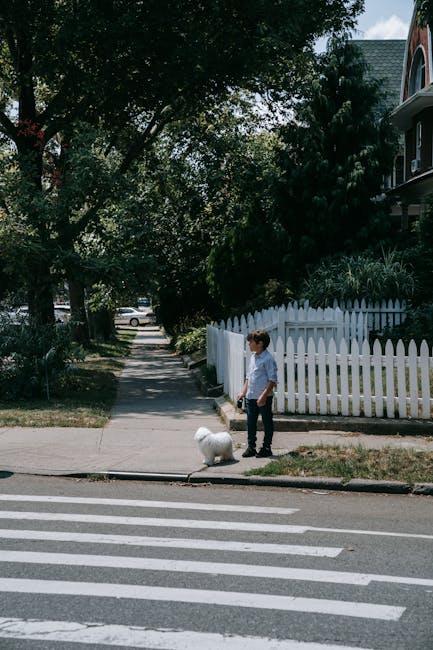Welcoming a new furry friend into your home is a heartwarming and exciting experience, filled with the promise of companionship and joy. However, for dogs, transitioning to a new environment can be both overwhelming and stressful. As a loving pet parent, your role in easing this adjustment is crucial. With patience, understanding, and a few strategic steps, you can help your canine companion feel safe, secure, and loved in their new surroundings. In this article, we will explore practical tips and techniques to ensure your dog’s smooth transition into their forever home, fostering a bond that will last a lifetime.
Creating a Safe and Comfortable Space for Your New Dog
Bringing a new dog into your home is an exciting adventure, but it also requires thoughtful preparation to ensure your furry friend feels safe and comfortable. Start by designating a quiet and cozy corner where your dog can retreat and relax. This space should be equipped with a comfortable bed, a few favorite toys, and a water bowl. Make sure this area is away from high-traffic zones to minimize stress and help your dog feel secure.
- Introduce familiar scents: Bring a blanket or toy from the shelter or previous home to provide comfort through familiar smells.
- Establish a routine: Dogs thrive on routine. Regular feeding times, walks, and play sessions help them understand what to expect and feel at ease.
- Limit new experiences initially: Allow your dog to explore the new environment gradually. Too many new experiences at once can be overwhelming.
- Positive reinforcement: Use treats and praise to encourage desired behavior and help build trust.
By creating a nurturing environment, you help your new companion adjust smoothly, setting the stage for a lasting, loving relationship.
Building Trust and Understanding Your Dogs Unique Needs
Understanding your dog’s unique needs is essential in fostering a strong bond and building trust. Every dog comes with its own set of quirks and preferences, and recognizing these can significantly ease their transition into a new home. Spend time observing your dog’s behavior and body language, and note what makes them feel comfortable or anxious. It’s crucial to create a safe and welcoming environment tailored to their needs. Consider the following tips:
- Establish a Routine: Dogs thrive on consistency. Create a daily schedule for feeding, walks, and playtime to provide a sense of security and predictability.
- Provide a Safe Space: Designate a quiet area where your dog can retreat when they feel overwhelmed. This can be a cozy corner with their bed or a crate that serves as a personal den.
- Engage in Positive Reinforcement: Use treats and praise to reward desired behaviors, helping your dog associate their new home with positive experiences.
- Be Patient and Attentive: Adjusting to a new home can be stressful for dogs. Offer plenty of love and patience as they explore and learn about their new surroundings.

Establishing a Consistent Routine for a Smooth Transition
When welcoming a new dog into your home, establishing a routine can be a comforting anchor for them. Dogs thrive on consistency, and a regular schedule can help them feel secure and adjust more quickly to their new environment. Here are some key elements to consider incorporating into your dog’s daily routine:
- Feeding Times: Serve meals at the same times each day. This not only aids in digestion but also helps set expectations, reducing anxiety around food.
- Walks and Exercise: Regular walks and play sessions at consistent times will help your dog burn off energy and provide a sense of stability.
- Rest Periods: Dogs need downtime just like humans. Create a cozy spot where your dog can retreat for naps and quiet time.
- Training Sessions: Short, daily training sessions reinforce good behavior and build trust between you and your pet.
Consistency in these areas not only eases your dog’s transition but also strengthens your bond, paving the way for a harmonious relationship. Remember, patience and understanding go a long way in helping your furry friend feel at home.

Encouraging Positive Social Interactions and Playtime
- Organize playdates: Arrange meet-ups with other dog owners in your neighborhood. This not only helps your furry friend make new friends but also gives them a chance to observe and learn social cues from more seasoned dogs. Look for dogs with compatible temperaments to ensure a harmonious interaction.
- Visit dog-friendly parks: Frequent visits to local parks can provide ample opportunities for your dog to socialize in a natural setting. Encourage your dog to explore, sniff around, and interact with other dogs at their own pace, while you supervise from a comfortable distance.
- Join a dog training class: Enrolling in a group training session can be beneficial for both you and your dog. These classes not only teach essential commands but also provide a controlled environment for socialization. Your dog will learn to focus on you amidst distractions, while also meeting other dogs in a structured setting.
- Provide interactive toys: Introduce toys that promote engagement and teamwork. Tug-of-war ropes or puzzle toys can be a great way to bond and encourage positive interactions. Make sure to rotate toys regularly to keep your dog stimulated and interested.
- Encourage gentle introductions: When meeting new dogs or people, ensure that introductions are slow and gentle. Allow your dog to approach at their own pace, offering praise and treats for calm behavior. This helps build confidence and reduces anxiety in new situations.

